Physical Address
304 North Cardinal St.
Dorchester Center, MA 02124
Physical Address
304 North Cardinal St.
Dorchester Center, MA 02124
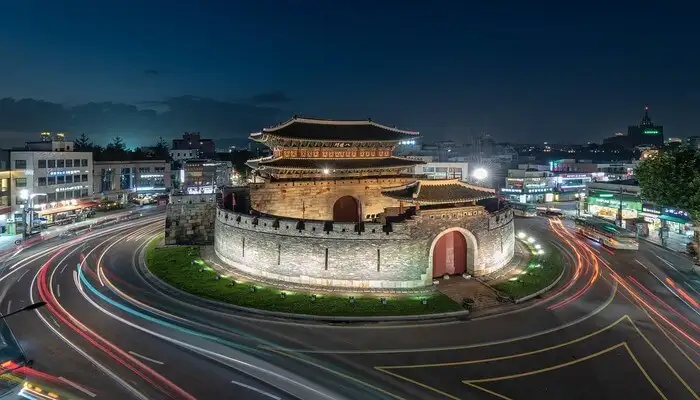
Are you ready to embark on a journey through South Korea’s UNESCO World Heritage Sites? From ancient palaces and temples to stunning natural wonders, this country has it all. Explore the history, culture, and beauty of South Korea as we take you on a tour of some of its most iconic sites.
Immerse yourself in the majesty of Seokguram Grotto and Bulguksa Temple, marvel at the geological wonder that is Jeju Volcanic Island and Lava Tubes, or step back in time with a visit to the Changdeokgung Palace Complex or Gyeongju Historic Areas. Whether you’re an architecture enthusiast or nature lover, South Korea’s UNESCO World Heritage Sites are sure to leave you awestruck. So pack your bags and get ready for an adventure like no other!
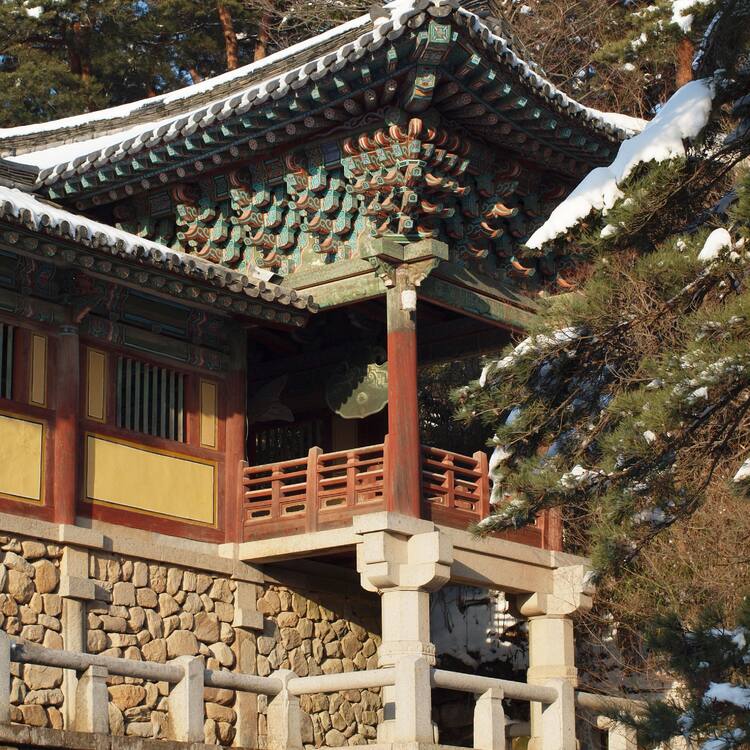
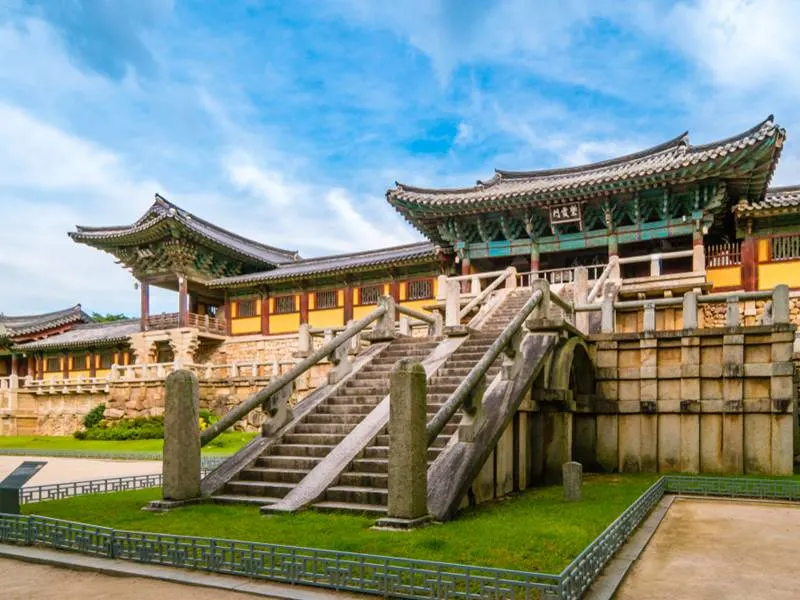
If you’re looking for a breathtaking glimpse into South Korea’s past, you can’t miss visiting Seokguram Grotto and Bulguksa Temple. These two UNESCO World Heritage Sites are located in the city of Gyeongju, and they showcase some of the country’s most impressive Buddhist art and architecture.
The Seokguram Grotto is a small cave temple that houses an enormous statue of Buddha carved out of granite. This statue is over 1,200 years old and is considered one of the greatest masterpieces of Buddhist art in Asia. The grotto itself is also an architectural marvel, with its intricate stone carvings and domed ceiling.
Bulguksa Temple, on the other hand, is a sprawling complex that dates back to the 8th century. It consists of several halls and courtyards that are adorned with beautiful sculptures, paintings, and pagodas. The main hall contains a large bronze Buddha statue as well as numerous other treasures from Korea’s ancient past. A visit to these two sites will give you a deeper appreciation for South Korea’s rich cultural heritage.
The Seokguram Grotto is renowned for the detailed artistry of its Buddha statue, embodying serene wisdom. This depiction is often viewed as a representation of enlightenment, with the detailed carvings around the statue illustrating key aspects of Buddhist teachings. The elaborate carvings include a variety of bodhisattvas, devas, and disciples surrounding the central Buddha, each positioned to convey deeply symbolic narratives.
As you leave Seokguram Grotto and Bulguksa Temple behind, make sure to head south towards Jeju Volcanic Island and Lava Tubes – another fascinating destination filled with natural wonders!


You’ll be amazed by the natural wonders of Jeju’s volcanic island and its intricate lava tubes. The island is home to Hallasan, South Korea’s highest peak, which showcases stunning views of the surrounding landscape. The volcanic rock formations and caves are also a sight to behold.
To fully appreciate Jeju’s unique natural beauty, here are four things you shouldn’t miss:
Jeju Island is not just a geologist’s dream but also a haven for wildlife enthusiasts. The island’s unique climate and volcanic soil support a wide range of flora and fauna. One notable resident is the Jeju pony, a breed native to the island, known for its resilience and small stature. In the island’s lush forests, you’ll find the camellia and persimmon trees, thriving alongside silvery magnolias. These natural wonders attract bird species like the fairy pitta and the Chinese sparrowhawk during their migratory journeys, making Jeju a lively spot for birdwatching.
Among Jeju Island’s natural marvels, the Manjanggul Lava Tube distinguishes itself by being one of the largest lava tube systems in the world. Stretching over 7.4 kilometers, this cave offers a unique glimpse into volcanic activity that shaped the island.
The tube’s interior is graced with a fascinating mix of lava stalactites, stalagmites, and shelves, features that were formed as the lava flowed and cooled. Notably, the Stone Turtle, a lava formation resembling the island of Jeju, is a popular attraction within the tube. The natural air conditioning within the cave provides a refreshing contrast to the tropical heat outside, drawing thousands who wish to experience this geological wonder firsthand.
Jeju Volcanic Island and Lava Tubes offer a glimpse into South Korea’s geological past and present-day culture. Visitors can explore the island’s pristine beaches, lush forests, and charming villages before venturing underground to see its unique lava formations up close. Next up: get ready to step back in time at Changdeokgung Palace Complex!
When you visit the Changdeokgung Palace Complex, get ready to be awed by the breathtaking beauty of traditional Korean architecture. Walk through its stunning halls and gardens while learning about the rich history of the royal family who once resided here. This UNESCO World Heritage Site is a must-see destination for anyone interested in immersing themselves in Korean culture and history.
Immerse yourself in the rich cultural heritage of South Korea by admiring the intricate details and designs of traditional Korean architecture. Explore the halls, pavilions, and gardens that make up these beautiful structures. From the vibrant colors to the curved roofs, each building is a true masterpiece.
One of the most famous examples of traditional Korean architecture is Changdeokgung Palace Complex. The palace was built over 600 years ago during the Joseon Dynasty and has since been recognized as a UNESCO World Heritage Site. As you walk through its gates, take in every detail of this stunning complex – from its wooden floors to its ornate decorations. You’ll truly feel transported back in time to experience life at court firsthand! Now, let’s learn about the royal family’s history…
Get ready to dive into the fascinating history of the royal family as you discover their legacy and impact on Korean culture. The Joseon Dynasty ruled Korea for over 500 years, leaving behind an incredible architectural legacy that can still be seen today. Here are three things you should know about the royal family’s history:
Within the Changdeokgung Palace lies the enchanting Secret Garden, or Huwon, an area once reserved for royalty. This garden sprawls over 78 acres, filled with lotus ponds, pavilions, and ancient trees. Wander through Buyongji Pond’s serene setting or pause by Juhamnu Pavilion, where kings pursued scholarly activities. The garden’s secluded tranquility offers insight into the royal lifestyle, harmonizing with nature while reflecting Korea’s esteemed landscape design that naturally integrates art with its natural surroundings.
As you explore South Korea’s UNESCO World Heritage Sites, keep these facts in mind as you witness firsthand the stunning architecture left behind by this powerful dynasty. Next up: let’s take a look at the historic areas of Gyeongju!
Are you ready to uncover the rich cultural heritage of the Silla Dynasty? Then head over to Gyeongju Historic Areas, where you’ll find a treasure trove of ancient tombs and temples that date back centuries. Explore this UNESCO World Heritage Site and immerse yourself in the history and culture of one of Korea’s most influential dynasties.
You’ll find yourself transported back in time as you explore the rich cultural heritage of the Silla Dynasty in South Korea’s UNESCO World Heritage sites. The Silla Dynasty ruled from 57 BC to 935 AD and left behind a lasting legacy that can be seen in their architecture, art, and traditions. Here are three things you won’t want to miss:
As you delve deeper into the fascinating world of Silla culture, don’t forget to visit ancient tombs and temples where you can learn more about this incredible dynasty’s legacy.
Now that you’ve learned about the rich cultural heritage of the Silla Dynasty, it’s time to explore more of South Korea’s UNESCO World Heritage Sites. One must-visit destination is the ancient tombs and temples scattered throughout the country.
The Gyeongju Historic Areas, for example, are home to over 150 tombs from the Silla period and several Buddhist temples. These sites offer a glimpse into Korea’s past with intricate carvings, delicate artwork, and well-preserved architecture. Additionally, Bulguksa Temple in Gyeongju is considered one of the most important Buddhist temples in Korea. Its peaceful atmosphere and stunning natural setting make it a popular spot for locals and tourists alike. So if you want to immerse yourself in South Korean history and culture, visiting these ancient tombs and temples should be at the top of your list.
Bungwangsa Temple is celebrated for its extraordinary pagoda, the oldest existing one in Korea. This iconic stone structure blends beautifully with the temple’s serene environment, offering a profound sense of historical continuity and spiritual peace.
Nearby, Tumuli Park serves as a colossal open-air museum, showcasing the Silla tomb mounds that rise impressively from the earth. These rounded tombs, built to last, are masterful constructions that symbolize the power and artistry of Silla’s ancient ruling class. Intriguingly, some of these tombs have been opened for exploration, revealing treasures of gold crowns and precious artifacts that offer a glimpse into the lives and deaths of Korea’s ancient aristocracy.
As you continue your journey through South Korea’s UNESCO World Heritage Sites, make sure not to miss out on Hwaseong Fortress in Suwon. This impressive fortress was built during the Joseon Dynasty as a means of protecting Seoul from foreign invasions. It features intricate walls, gates, watchtowers, and other defensive structures that have been beautifully preserved over time. Walking along its walls gives visitors an unparalleled view of Suwon City below while allowing them to step back into history at the same time.
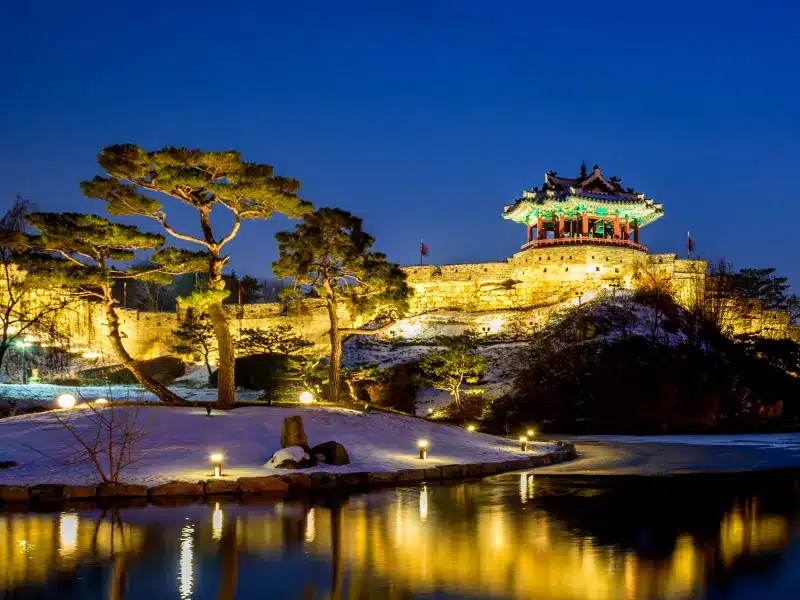
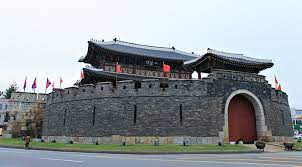
Get ready to explore Hwaseong Fortress and learn about the military strategy behind its design. This UNESCO World Heritage Site in Suwon City, South Korea was built in the late 18th century and served as a crucial defense structure during the Joseon Dynasty. As you walk along its walls, you’ll also be treated to stunning views of the surrounding cityscape.
Hwaseong Fortress has been subject to numerous restoration projects, ensuring its preservation for future generations. These commenced in the early 1970s, using historical techniques along with modern technology to strengthen its structure. Detailed reconstruction of walls and gates adhered closely to original designs, employing both traditional materials and contemporary methods. This meticulous process not only restores its former glory but also respects the historical legacy of the fortress, providing visitors with a window into the architectural prowess of the Joseon era.
Discover the military tactics used in the design of Hwaseong Fortress and appreciate its historical significance. As you explore the fortress, you will see various features that were designed for strategic purposes. For example, there are multiple gates with different functions such as the Janganmun Gate which was used for defense against enemy attacks and the Paldalmun Gate which was built to allow easy access for civilians and merchants. The walls also have unique shapes and sizes depending on their location, making it difficult for enemies to predict where they could launch an attack.
Hwaseong Fortress is not merely a symbol of military prowess but also a masterpiece of early modern Korean architecture and engineering. Its construction utilized advanced methods and innovative techniques for the time, carefully chronicled in the Hwaseong Seongyeok Uigwe, a historic construction manual.
The fortress incorporated then-modern concepts of bastion defense and practical gate design. Its walls stretch 5.7 kilometers, incorporating four main gates and various secret gates and passageways, blending effortlessly with the landscape while providing formidable defense mechanisms. This harmonious integration with nature still evokes admiration among architects and historians today.
Moreover, Hwaseong Fortress has underground tunnels that were used by soldiers to move around secretly during battles. These tunnels were also equipped with traps like hidden doors in case attackers managed to enter them. You can imagine how well thought out each aspect of the fortress’s design is and how it played a significant role in protecting Suwon City from invaders. With every step you take, you’ll gain a deeper appreciation of South Korea’s history and culture.
As you finish exploring Hwaseong Fortress’s military strategy, get ready to enjoy the scenic views of Suwon City!
As you walk along the fortress walls, you’ll be treated to breathtaking views of Suwon City. The city’s unique blend of traditional and modern architecture is on full display, with the towering skyscrapers in the distance contrasting beautifully against the historic buildings below. Take a moment to appreciate the vibrant colors of the tiled roofs and winding alleyways that make up this charming city.
As you continue your stroll, be sure to stop at one of the lookout points along the way. From these vantage points, you can soak in panoramic views of Suwon City and its surrounding natural beauty. On clear days, you may even catch a glimpse of distant mountains peeking out from behind fluffy white clouds. It’s easy to see why Suwon City is considered one of South Korea’s most picturesque destinations – with every step along its fortress walls offering new perspectives on its captivating beauty.
Seokguram Grotto and Bulguksa Temple are two of South Korea’s most impressive cultural and religious sites. The construction of these UNESCO World Heritage Sites dates back to the 8th century during the reign of Silla Dynasty. The grotto was built as a place for meditation, while the temple functioned as a center for Buddhist learning and worship. Both structures were designed by master architects and craftsmen who used unique building techniques that have withstood the test of time. The site’s intricate carvings, statues, and paintings reflect the artistry and craftsmanship of the ancient Koreans. Today, visitors can explore these architectural marvels to experience a deep sense of history, culture, and spirituality in one visit.
UNESCO awards World Heritage status based on criteria like cultural significance, historical importance, and natural beauty. For example, sites like Jeju Volcanic Island, recognized for their geological uniqueness, highlight Earth’s formative processes. Simultaneously, cultural landmarks like the Changdeokgung Palace demonstrate the socio-historical traditions they have preserved. These sites collectively embody the chronicles of human ingenuity and nature’s splendor, underscoring their global cultural value.
Jeju Island, the largest island in South Korea, was formed about two million years ago due to volcanic activity. The island is home to three major shield volcanoes and is surrounded by smaller parasitic cones. Its unique geological features include numerous craters, lava tubes, and volcanic cones. The Jeju lava tubes were created when the outer part of the lava flow cooled rapidly while the inner part continued flowing. This resulted in a hollow space where molten lava once flowed. These tubes are some of the longest in the world and have been designated as a UNESCO World Heritage Site due to their scientific value. Exploring these natural wonders on Jeju Island will take you on an incredible journey through millions of years of geological history!
Changdeokgung Palace Complex is a significant historical landmark in South Korea, offering a glimpse into the country’s rich cultural heritage. Built during the Joseon Dynasty, this palace complex served as the royal residence for many Korean monarchs. The palace is renowned for its stunning architecture and intricate design, which reflects traditional Korean aesthetics and cosmology. Notably, the palace was designed to harmonize with its natural surroundings and features beautiful gardens that are highly regarded for their beauty and tranquility. Today, Changdeokgung Palace Complex stands as a testament to Korea’s rich history and cultural traditions, attracting visitors from all over the world who come to learn about this remarkable site firsthand.
If you’re looking to explore some lesser-known historic areas in Gyeongju, there are a few that should definitely make it onto your itinerary. One such place is the Bunhwangsa Temple, which dates back to the 7th century and is known for its beautiful pagoda. Another must-visit spot is Tumuli Park, which features ancient burial mounds from the Silla dynasty. For a glimpse into traditional Korean life, head over to Yangdong Village, where you can see well-preserved traditional homes and learn about the culture of the Joseon era. Finally, don’t miss out on Seokguram Grotto, a stunning Buddhist cave temple with intricate carvings and breathtaking views of the surrounding mountainside. These historic sites offer an opportunity to step back in time and experience some of Korea’s rich cultural heritage firsthand.
A visit to Yangdong Village offers a captivating look into Korea’s past, emphasizing traditional Confucian culture and its historic lineage. This picturesque village, nestled amidst mountaintops and rivers, is a vivid reflection of Korea’s antebellum life, with over 160 well-preserved traditional houses reflecting the lifestyle of the Joseon era’s elite yangban class.
Exploring its winding paths, you’ll uncover rich cultural traditions that remain alive, from folk music performances to seasonal festivals celebrated by the residents. Each house tells a story of the family lineage and Confucian values that governed the lives of past inhabitants. Visiting Yangdong Village provides a deeper understanding of Korea’s cultural identity and community life, linking the visitor to traditions that have endured through the ages.
To answer your question, the Hwaseong Fortress was built in the late 18th century by King Jeongjo of the Joseon Dynasty. It took approximately two and a half years to complete, with construction beginning in 1794 and ending in 1796. The fortress is made primarily of stone and brick, with wooden gates and watchtowers. The walls are over five kilometers long and contain four main gates, as well as smaller entrances for soldiers and civilians. The fortress served as a strategic military base for centuries, protecting the city of Suwon from invasions. Today it is recognized as a UNESCO World Heritage Site and attracts visitors from all over the world who come to marvel at its unique architecture and rich history.
You started your journey at Seokguram Grotto and Bulguksa Temple, where you marveled at the intricate stone carvings and peaceful atmosphere. Then you traveled to Jeju Volcanic Island and Lava Tubes, where you explored underground caves formed by ancient volcanic eruptions. Next, you visited Changdeokgung Palace Complex, admiring the elaborate architecture and lush gardens. In Gyeongju Historic Areas, you discovered ancient tombs and temples that date back thousands of years. Finally, at Hwaseong Fortress, you felt like a true warrior as you walked along the impressive walls built in the 18th century.
As you reflect on your journey through South Korea’s UNESCO World Heritage Sites, it’s clear that this country has so much to offer in terms of history and culture. From stunning temples to majestic fortresses, every site is truly unique and unforgettable. So why not plan your own trip to South Korea today? Who knows what wonders you’ll discover when you’re there in person!